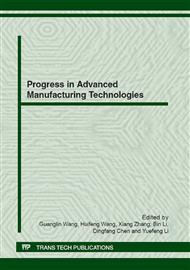p.574
p.578
p.582
p.587
p.593
p.598
p.602
p.606
p.613
Vibration Model Construction of the CNC Embroidery Machine Based on the Timoshenko Beam Theory and its Experimental Research
Abstract:
With its technological development, the CNC embroidery machine rotational speed has increased dramatically. Consequent vibration and noise increase the disconnection rate in the embroidery process and affect the embroidery quality and production efficiency. To solve such problem, by analyzing the vibration causes and comparing the different characteristics of the Timoshenko beam and the Euler-Benouli simply supported beam, the current study indicated the limitation of the traditional vibration analysis method---the widely-used Euler-Bernouli simple beam theory, and constructed a vibration model based on the Timoshenko beam theory. Then a finite element model of the embroidery machine beam was built S and the corresponding experiment were done. Results from the constructed mechanical, mathematical model, and the ANSYS finite element model were compared. It has been verified that the constructed models are consistent with experiment results and that vibration models are constructed reasonably and feasibly. According to these models, the key parameters affecting the beam vibration are identified to work out more accurate and effective structure optimization design and prediction.
Info:
Periodical:
Pages:
593-597
Citation:
Online since:
August 2012
Price:
Сopyright:
© 2012 Trans Tech Publications Ltd. All Rights Reserved
Share:
Citation:


